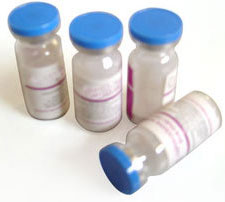|
 Indications and Usage :
Indications and Usage :
Treatment of infections of lower respiratory tract including
pneumonia, urinary tract, skin and skin structures, bone and
joints; treatment of bacteremia/septicemia, CNS infections,
intra-abdominal infections including peritonitis, gynecological
infections including pelvic inflammatory disease, endometritis and
pelvic cellulitis caused by susceptible strains of specific
microorganisms; perioperative prophylaxis.
 Contraindications :
Contraindications :
Hypersensitivity to cephalosporins.
 Dosage and Administration :
Dosage and Administration :
Infection
Adults
IV/IM Up to 12 g/day in divided doses (from every 4 h for
septicemia to every 12 h for uncomplicated infection) usually for
7 to 10 days. IV route is preferable for severe infections.
Children 1 mo to 12 yr of age (weighing less than 50 kg)
IV/IM 50 to 180 mg/kg/day in 4 to 6 divided doses.
Children 1 mo to 12 yr of age (weighing more than 50 kg)
Usual adult dose (max, 12 g/day).
Infants 1 to 4 wk of age
IV 50 mg/kg every 8 h.
Newborns younger than 1 wk of age
IV 50 mg/kg every 12 h.
Gonococcal Urethritis/Cervicitis in Men and Women
Adults
IM 0.5 g as single dose.
Rectal Gonorrhea
Adults
IM 0.5 g as single dose (women); 1 g as single dose (men).
Perioperative Prophylaxis
Adults
IV/IM 1 g 30 to 90 min prior to surgery.
Cesarean Section
Adults
IV 1 g as soon as umbilical cord is clamped; second and third dose
IV/IM at 6- and 12-h intervals after first dose.
 Dosage Adjustment for Renal Function Impairment
Dosage Adjustment for Renal Function Impairment
Reduce dose 50% in patients with Ccr less than 20 mL/min.
 General Advice :
General Advice :
* For IM or IV administration only. Not for intradermal,
subcutaneous, or intra-arterial administration.
* IV route preferred for severe or life-threatening infections, or
for patients who may be poor risks because of lowered resistance.
* Follow manufacturer's guidelines for reconstitution of sterile
powder with respect to diluent volume, withdrawable volume, and
approximate final concentration.
* For IM administration, reconstitute vials with sterile water for
injection or bacteriostatic water for injection.
* For IV administration, reconstitute vials with at least 10 mL
sterile water for injection; reconstitute infusion bottles with 50
or 100 mL sodium chloride 0.9% injection or dextrose 5% injection.
* Shake to dissolve.
* Thaw premixed frozen injection at room temperature or under
refrigeration (at or below 41°F). Do not force thaw by immersion
in water baths or microwave irradiation. Check container for
minute leaks by squeezing container firmly. Discard container if
leaks are detected. Do not use plastic containers in series
connections because of risk of air embolism.
* Reconstituted or thawed solution should be clear and pale to
light yellow in color. Do not use if discolored, cloudy, or
contains particulate matter.
* Intermittent IV administration: solution containing 1 or 2 g
cefotaxime in 10 mL sterile water for injection can be injected
over a period of 3 to 5 min. Do not administer over a period of
less than 3 min. Can also be administered via infusion system over
longer period of time; temporarily discontinue administration of
other solutions at same site during infusion of cefotaxime.
* For continuous IV infusion, add solution of cefotaxime to IV
bottles containing compatible fluids (sodium chloride 0.9%
injection, dextrose 5% or 10% injection, dextrose 5% and sodium
chloride 0.9%, 0.45%, or 0.2% injection, Ringer's lactate
solution, sodium lactate injection, invert sugar 10% solution,
Travasol 8.5% amino acid injection without electrolytes.
* For IM administration. Dose of 2 g may be given if dose is
divided and administered at different sites.
 Storage/Stability :
Storage/Stability :
Store vials and bottles of dry powder below 86°F. Protect from
light and excessive temperature. Refer to manufacturer's
guidelines for storage and stability recommendations for
reconstituted solutions. Store premixed frozen injection in
freezer capable of maintaining temperature of −4°F. Thawed
solution is stable for 10 days under refrigeration (at or below
41°F) or 24 h at or below 72°F. Do not refreeze thawed
antibiotics.
|






